Weil-McLain CGs, CGi, PEG, LGB, 7 PFG User Manual
...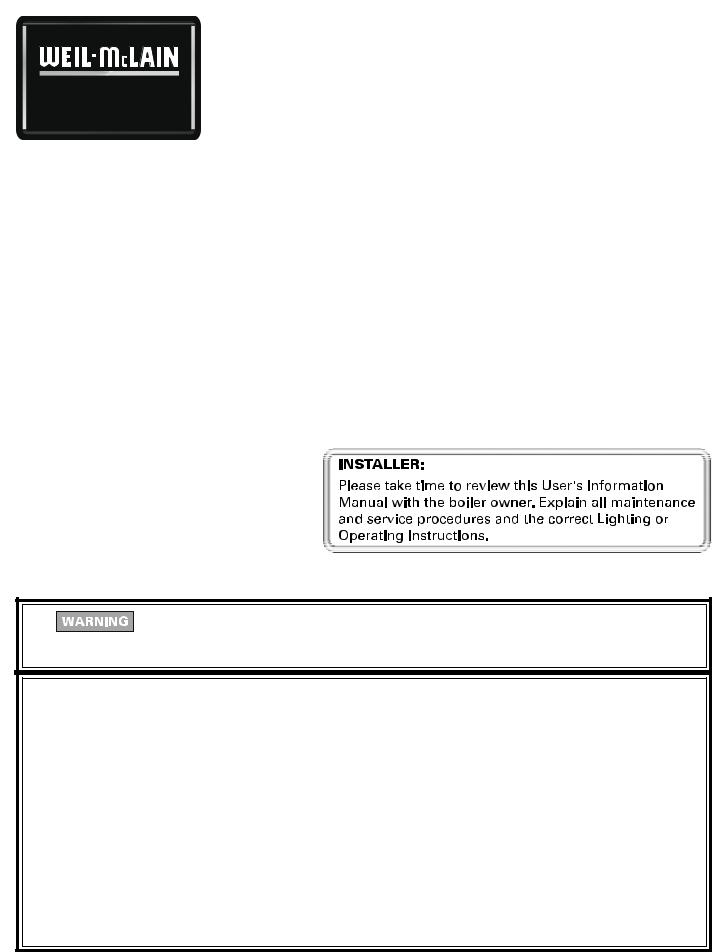
CGa, CGi, CGs, EG,
EGH, LGB, PEG, PFG
Gas-Fired Boilers
User’s
Information
Manual
If the information in this manual is not followed exactly, a fire or explosion may result, causing property damage, personal injury or loss of life.
Do not store or use gasoline or other flammable vapors and liquids in the vicinity of this or any other appliance.
WHAT TO DO IF YOU SMELL GAS
•Do not try to light any appliance.
•Do not touch any electrical switch; do not use any phone in your building.
•Immediately call your gas supplier from a neighbor’s phone. Follow the gas supplier’s instructions.
•If you cannot reach your gas supplier, call the fire department.
Installation and service must be performed by a qualified installer, service technician or the gas supplier.
Part Number 550-110-592/1000
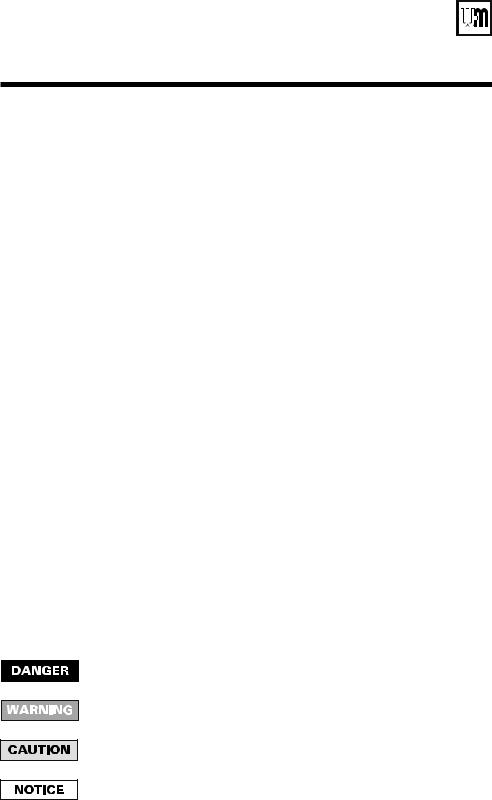
CGa, CGi, CGs, EG, EGH, LGB, PEG, PFG Boilers
Please read this page first
How to use this |
|
|
|
|
To . . . |
Read/use . . . |
Pages . . . |
||
manual . . . |
||||
|
|
|
||
|
Learn |
Warnings and definitions |
1, 2, and 3 |
|
|
precautions |
|||
|
|
|
||
|
|
|
|
|
|
Prevent air |
Read list of air contaminants you must avoid. If |
|
|
|
found, either remove products permanently |
3 |
||
|
contamination |
or isolate boiler and provide outside com- |
||
|
|
|||
|
|
bustion air. |
|
|
|
|
|
|
|
|
Identify boiler |
The illustration on page 4 or 5, will show you the |
4-5 |
|
|
components |
location of the main components. |
||
|
|
|||
|
|
|
|
|
|
Maintain |
Set up a plan for maintaining the boiler using |
|
|
|
the schedule included in this manual. |
6-12 |
||
|
boiler |
Schedule an annual start-up by a qualified ser- |
||
|
|
|||
|
|
vice technician before every heating season. |
|
|
|
|
|
|
|
|
Start — or — |
Use the Lighting/Operating instruction sheet |
|
|
|
for the gas valve installed on your boiler. Ask |
|
||
|
Shutdown |
12-22 |
||
|
your service technician if you are unsure which |
|||
|
boiler |
|
||
|
one. |
|
||
|
|
|
||
|
|
|
|
|
|
Troubleshoot |
Use the common problems/solutions table to |
|
|
|
common |
23 |
||
|
resolve typical heating system/boiler problems. |
|||
|
problems |
|
||
|
|
|
||
|
|
|
|
Hazard definitions
Boiler service and maintenance
2
The following defined terms are used throughout this manual to bring attention to the presence of hazards of various risk levels or to important information concerning the life of the product.
Indicates presence of hazards that will cause severe personal injury, death or substantial property damage.
Indicates presence of hazards that can cause severe personal injury, death or substantial property damage.
Indicates presence of hazards that will or can cause minor personal injury or property damage.
Indicates special instructions on installation, operation or maintenance that are important but not related to personal injury or property damage.
The User’s Information Manual provides information to the boiler owner/user for routine operation and maintenance and emergency shutdown. Detailed information on boiler installation, operation, start-up, service and parts is included in the Boiler Manual. The Boiler Manual is intended only for use by a qualified installer/service technician.
Part Number 550-110-592/1000
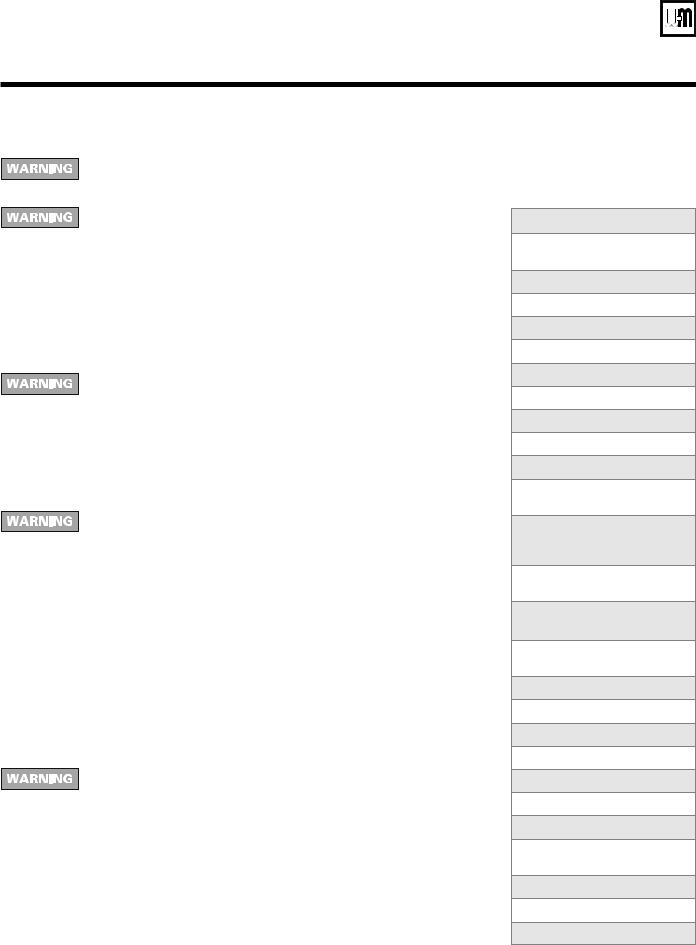
User’s Information Manual
STOP!! — Read before proceeding
Failure to adhere to the guidelines on this page can result in severe personal injury, death or substantial property damage.
Air contamination
•To prevent potential of severe personal injury or death, check for products or areas listed in table at right before installing boiler. If any of these contaminants are found:
• remove contaminants permanently. |
— OR — |
•isolate boiler and provide outside combustion air. See national, provincial or
local codes for further information. |
— OR — |
•for CGs boilers only — combustion air may be ducted from outside to the boiler air intake.
Service and maintenance
•To avoid electric shock, disconnect electrical supply before performing maintenance.
•To avoid severe burns, allow boiler to cool before performing maintenance.
•You must maintain the boiler as outlined in the manual and have the boiler started up and serviced at least annually by a qualified service technician to ensure boiler/system reliability.
Boiler operation
•Do not block flow of combustion or ventilation air to boiler. This boiler is equipped with a control which will automatically shut down the boiler should air or vent be blocked. If vent or air blockage is easily accessible and removable, remove it. The boiler should attempt to restart within an hour. If blockage is not obvious or cannot be removed, have the boiler and system checked by a qualified service technician.
•Should overheating occur or gas supply fail to shut off, do not turn off or disconnect electrical supply to pump. Instead, shut off the gas supply at a location external to the appliance.
•Do not use this boiler if any part has been under water. Immediately call a qualified service technician to inspect the boiler and to replace any part of the control system and any gas control, which has been under water.
•Have the building monitored when it is vacant for an extended period. Safety controls can shut down the boiler at any time. The loss of heat can result in significant damage due to freezing.
Boiler water
•DO NOT use petroleum-based cleaning or sealing compounds in boiler system. Water seal deterioration will occur, causing leakage between sections and damage to heating system components. This can result in substantial property damage.
•DO NOT use "homemade cures" or "boiler patent medicines". Serious damage to boiler, personnel and/or property may result.
•Continual fresh makeup water will reduce boiler life. Mineral buildup in sections reduces heat transfer, overheats cast iron, and causes section failure. Addition of oxygen and other gases can cause internal corrosion. Leaks in boiler or piping must be repaired at once to prevent makeup water.
•Do not add cold water to hot boiler. Thermal shock can cause sections to crack.
Products to avoid
Spray cans containing chloro/fluorocarbons
Permanent wave solutions
Chlorinated waxes/cleaners
Chlorine-based swimming pool chemicals
Calcium chloride used for thawing
Sodium chloride used for water softening
Refrigerant leaks
Paint or varnish removers
Hydrochloric acid/muriatic acid
Cements and glues
Antistatic fabric softeners used in clothes dryers
Chlorine-type bleaches, detergents, and cleaning solvents found in household laundry rooms
Adhesives used to fasten building products and other similar products
Areas likely to have contaminants
Dry cleaning/laundry areas and establishments
Swimming pools
Metal fabrication plants
Beauty shops
Refrigeration repair shops
Photo processing plants
Auto body shops
Plastic manufacturing plants
Furniture refinishing areas and establishments
New building construction
Remodeling areas
Garages with workshops
Part Number 550-110-592/1000 |
3 |
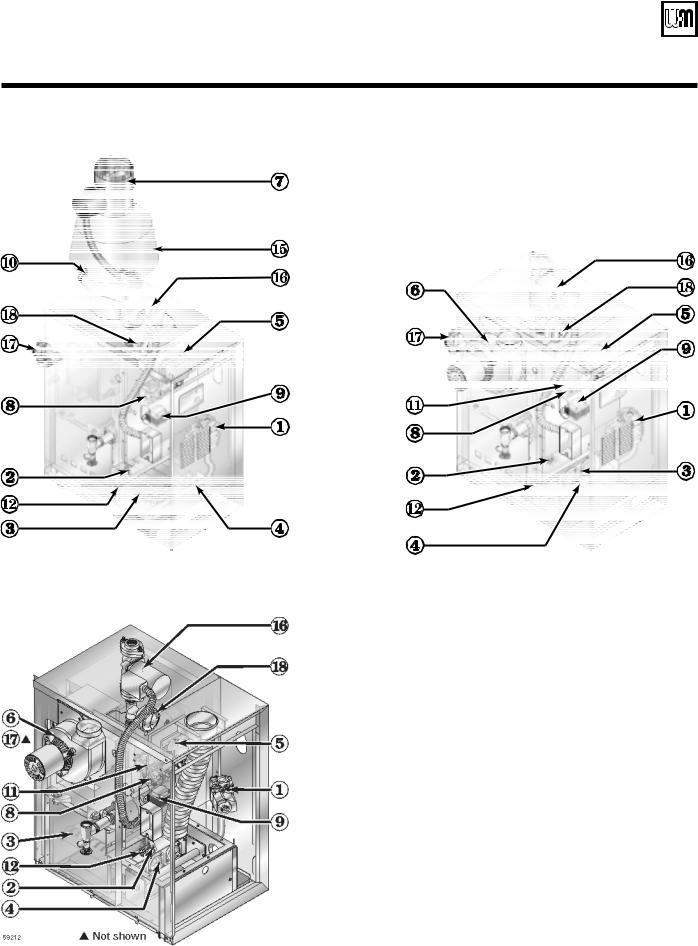
CGa, CGi, CGs, EG, EGH, LGB, PEG, PFG Boilers
Boiler components
CGa |
CGi |
CGs
59210 |
59211 |
1Gas valve
2Pilot burner
3Main burner
4Gas manifold/orifices
5Control module
6Inducer (CGi and CGs only)
7Vent damper (CGa only)
8Water temperature limit switch
9Transformer
10Spill switch (CGa only)
11Air pressure switch (CGi and CGs only)
12Rollout thermal fuse element
15 |
Draft hood (CGa only) |
16 |
Circulator |
17 |
Relief valve |
18 |
Gauge (pressure or pressure/temperature) |
4 |
Part Number 550-110-592/1000 |
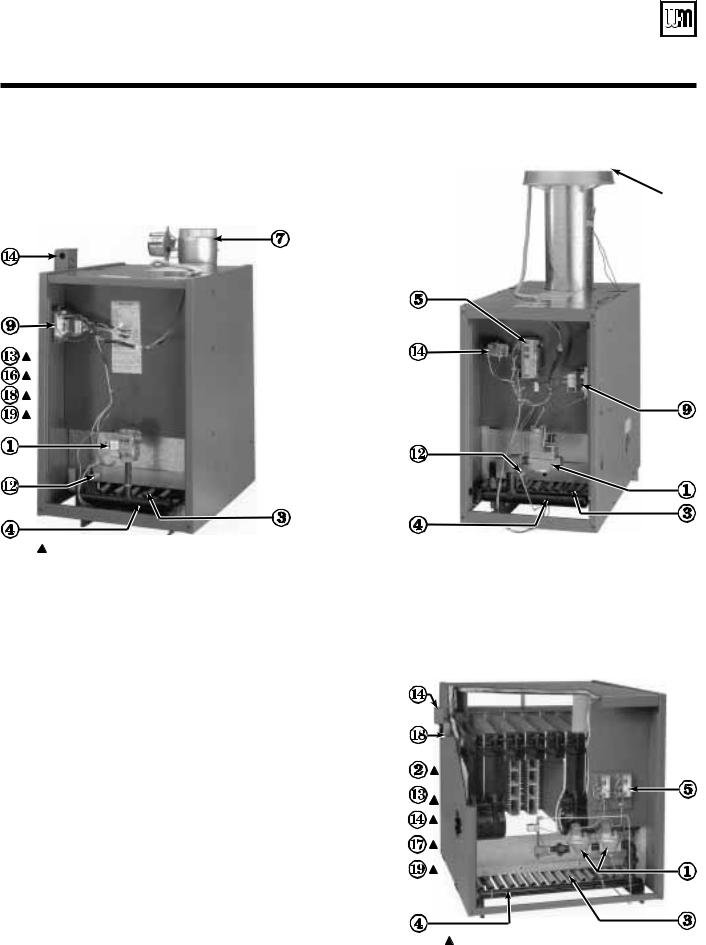
User’s Information Manual
EG/EGH
 ▲
▲
 ▲
▲
 ▲
▲
 ▲
▲
Not shown |
59213 |
1Gas valve
2Pilot burner
3Main burner
4Gas manifold/orifices
5Control module
7 Vent damper
9Transformer
10Spill switch
12Rollout thermal fuse element
13Low water cutoff (steam boilers)
14Limit control(s)
15Draft hood
16Circulator
18Gauge (pressure or pressure/temperature)
19Gauge glass (steam only)
Part Number 550-110-592/1000
PFG
 ▲
▲
(PFG-5 only)
 ▲
▲
 ▲
▲
 ▲
▲
(PFG-5 only)
▲ Not shown |
59215 |
LGB
Not shown |
59214 |
5
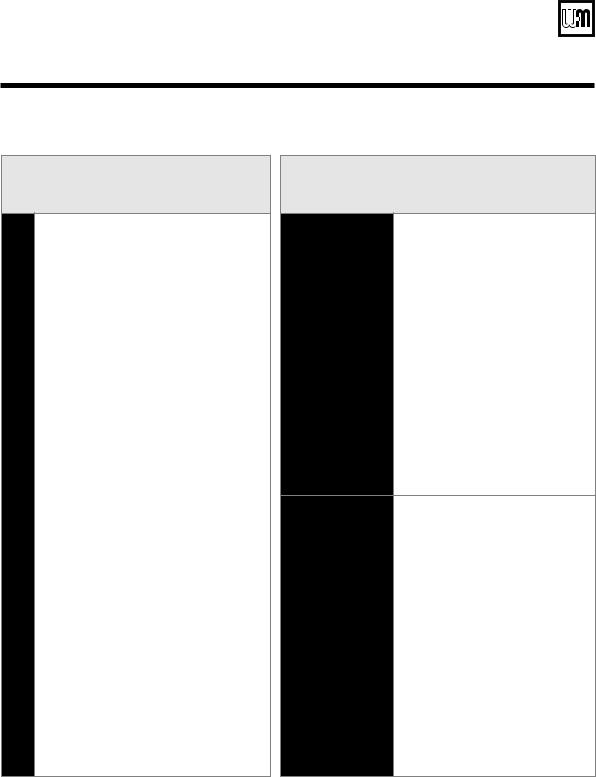
CGa, CGi, CGs, EG, EGH, LGB, PEG, PFG Boilers
Maintain boiler using schedule below
Service technician
(covered in Boiler Manual — for use only by a qualified service technician)
|
Inspect: |
||
|
• Reported problems |
||
|
• |
Boiler area |
|
|
• |
Air openings |
|
|
• Flue gas vent system |
||
|
• |
Pilot and main burner flames |
|
|
• |
Water piping |
|
-UP |
• |
Boiler heating surfaces |
|
• |
Burners, base and inlet air box |
||
START |
|||
Service: |
|||
|
|||
NNNUAL |
• |
Oiled-bearing circulators |
|
Check/test: |
|||
|
Start-up: |
||
|
• |
Perform start-up per manual |
|
A |
• Gas piping |
||
|
|||
|
• |
Cold fill and operating pressures |
|
|
• |
Air vents and air elimination |
|
|
• |
Limit controls and cutoffs |
|
|
• Expansion tank |
||
|
• |
Boiler relief valve |
|
|
Review: |
||
Owner maintenance
(see following pages for instructions)
|
• |
Check boiler area |
Daily |
• Check air openings |
|
|
|
|
|
• |
Check boiler pressure/ |
|
|
temperature gauge |
|
|
|
|
• |
Check boiler interior piping |
|
• Check venting system |
|
Monthly |
• |
Check air vents |
|
|
|
|
• |
Check boiler relief valve |
|
• |
Check automatic air vents (if |
|
|
used) |
|
|
|
Periodically |
• |
Test low water cutoff (if used) |
|
|
|
Every 6 months |
• |
Operate relief valve |
|
|
|
End of season • Shut down procedure
• Review with owner
Tankless water heater (EG and EGH
only) |
requirements. Differential can be set to 15 ° and adjusted |
If boiler is used to supply domestic hot water, limit |
|
control should be set to supply adequate hot water. |
to control level. Lowering the differential will cause a |
Weil-McLain tankless heaters are rated at 200 °F boiler |
slight variation in water temperature but will decrease |
water temperature. To get rated output, set low limit at |
burner on-off cycling. High limit should be set at least |
200 °F. Limit can be adjusted to meet system hot water |
20 ° above low limit. |
6 |
Part Number 550-110-592/1000 |
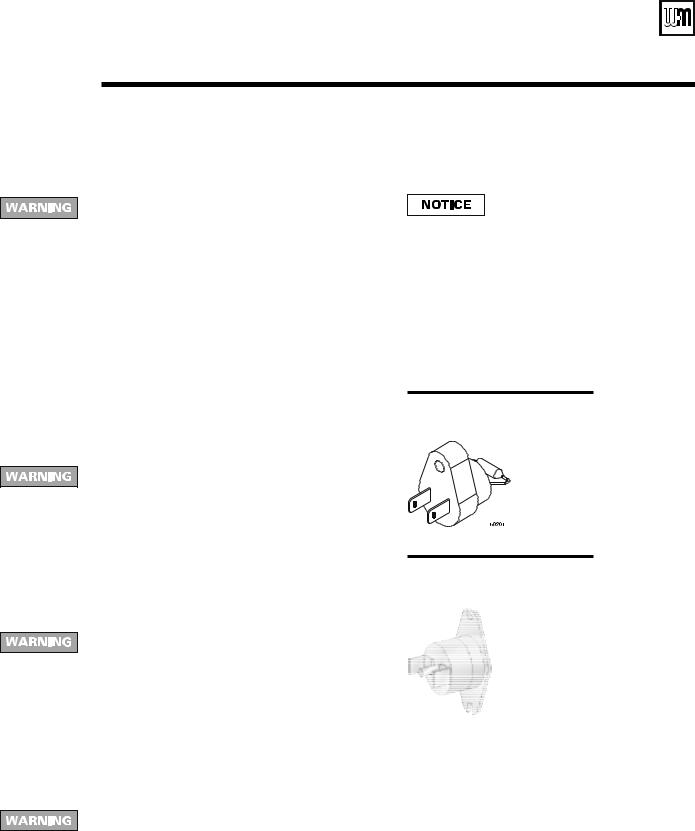
User’s Information Manual
User maintenance procedures
Boiler must be serviced & maintained
The boiler should be inspected and started annually, at the beginning of the heating season, only by a qualified service technician. In addition, the maintenance and care of the boiler designated on page 6 and explained on the following pages must be performed to assure maximum boiler efficiency and reliability. Failure to service and maintain the boiler and system could result in equipment failure, causing possible severe personal injury, death or substantial property damage.
The following information provides detailed instructions for completing the maintenance items listed in the maintenance schedule, page 6. In addition to this maintenance, the boiler must be serviced and started up at the beginning of each heating season by a qualified service technician.
Component information
Rollout thermal fuse element
CGa, CGi, CGs, EG, EGH, PEG & PFG-5 only
Cuts off gas flow should flame rollout occur. See
Figure 1.
Do not attempt to place boiler in operation if rollout thermal fuse element cuts off gas flow. Immediately call a service technician. Failure to do so can cause severe personal injury, death or substantial property damage.
Figure 1
Rollout thermal fuse element
Spill switch
CGa, EG, EGH, PEG & PFG-5 only
Cuts off gas flow should vent system become blocked. See Figure 2.
Do not attempt to place boiler in operation if spill switch cuts off gas flow. Immediately call a service technician. Failure to do so can cause severe personal injury, death or substantial property damage.
Figure 2
Spill switch
59202
Check daily . . . . . . . . . . . . . . . . .
Boiler area
To prevent potential of severe personal injury, death or substantial property damage, eliminate all materials discussed below from the boiler vicinity. If found:
•Remove products immediately from the area. If they have been there for an extended period, call a qualified service technician to inspect the boiler and vent system for possible damage from acid corrosion.
•If products cannot be removed, immediately call a
qualified service technician to install an outside combustion air source for the boiler (if not already installed).
1.Combustible/flammable materials — Do not store combustible materials, gasoline or any other flammable vapors or liquids near the boiler. Remove immediately if found.
2.Air contaminants — See listing of contaminants on page 3.
Part Number 550-110-592/1000 |
7 |
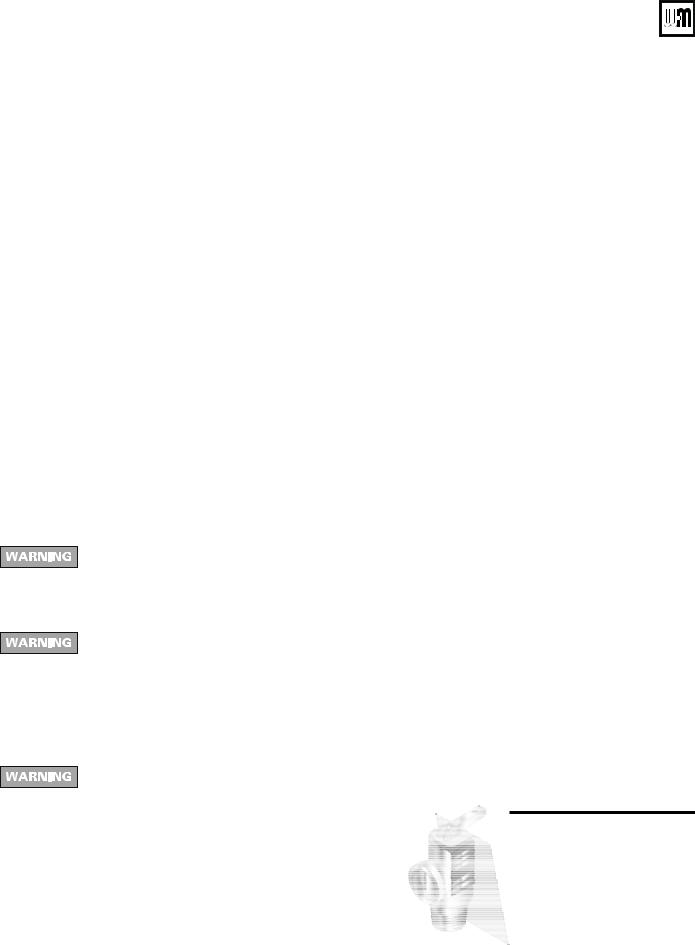
CGa, CGi, CGs, EG, EGH, LGB, PEG, PFG Boilers
Check daily . . . . . . . . . . . . . . . . .
Pressure/temperature gauge or pressure gauge (steam)
1.Water boilers — Make sure the pressure reading on the boiler pressure/temperature gauge does not exceed 24 psig. Higher pressure may indicate a problem with the expansion tank or gauge.
2.Steam boilers — Make sure the pressure reading on the boiler pressure gauge does not exceed 15 psig. Higher pressure indicates a problem with the gauge or limit control.
Air openings
1.Verify that combustion and ventilation air openings to the boiler room and/or building are open and unobstructed.
2.CGs boilers — Verify that boiler vent discharge and air intake are clean and free of obstructions. Remove any debris on the air intake or flue exhaust openings.
3.Contact a qualified service technician if problem persists.
Check monthly . . . . . . . . . . . . . . . .
Boiler piping
1.Visually inspect for leaks around piping, circulators, relief valve and other fittings. Immediately call a qualified service technician to repair any leaks.
Have leaks fixed at once by a qualified service technician. Continual fresh makeup water will reduce boiler life. Minerals can build up in sections, reducing heat transfer, overheating cast iron, and causing section failure.
Do not use petroleum-based cleaning or sealing compounds in boiler system. Severe damage to boiler and system components can occur, resulting in possible severe personal injury, death or substantial property damage.
Venting system
Failure to inspect the vent system as noted above and have them repaired by a qualified service technician can result in vent system failure, causing severe personal injury or death.
1.Visually inspect all parts or the flue gas venting system for any signs of blockage, leakage or joints or deterioration of the piping.
2.CGa and EG boilers:
a.With boiler firing, hold a candle or match below lower edge of draft hood “skirt.” If flame does not blow out, but burns undisturbed, the vent system is working properly.
If flame blows out or flickers severely, the vent system must be checked for obstructions or other causes of improper venting.
b.Verify the vent damper (CGa and EG boilers) opens before burners ignite.
3.Notify your qualified service technician at once if you find any problem.
Boiler relief valve . . . . . . . . .
1.Inspect the boiler relief valve (see Figure 3) and the relief valve discharge pipe for signs of weeping or leakage.
2.If the relief valve often weeps:
•water boilers — the expansion tank may not be working properly.
•steam boilers — limit control may be set too high or there may be system problems.
•Immediately contact your qualified service technician to inspect the boiler and system.
Figure 3 Relief valve
59203
8 |
Part Number 550-110-592/1000 |
